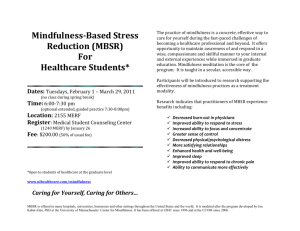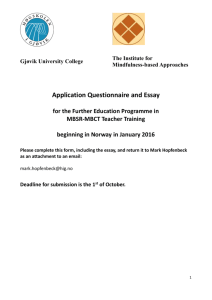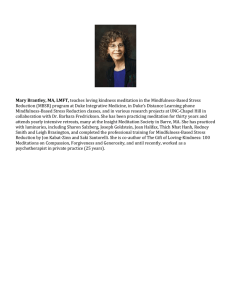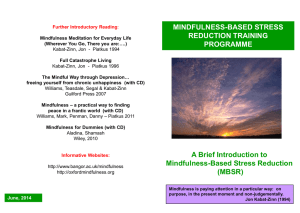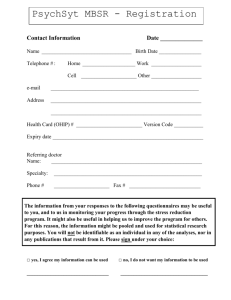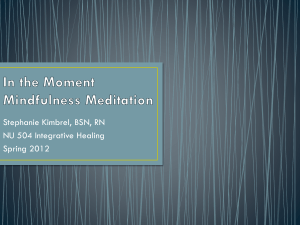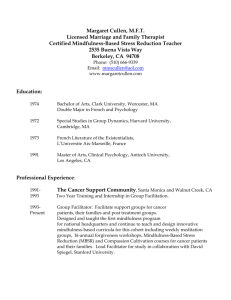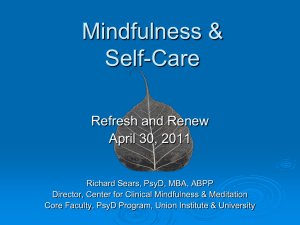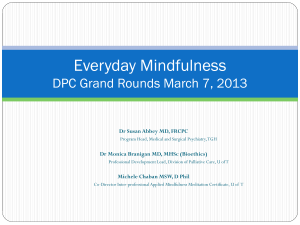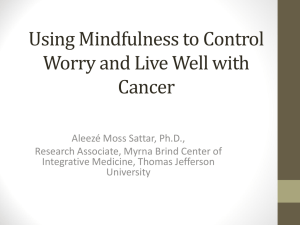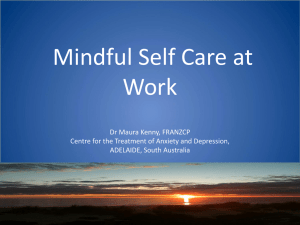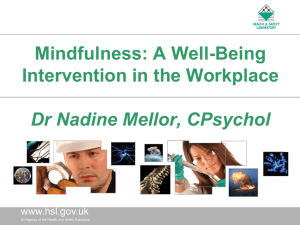Developing Inner Technology (PowerPoint)
advertisement
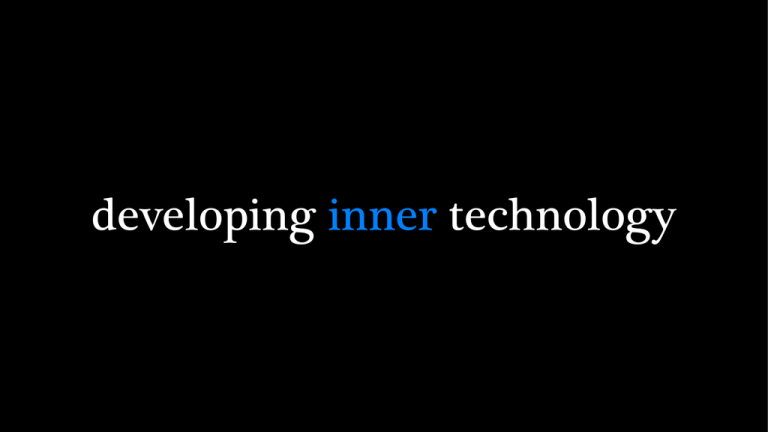
developing inner technology welcome When I was six my dad took me to see a movie. That movie sparked my interest in technology. Another reason I love the movie is that it teaches the viewer that external technology can be dangerous if we do not balance it with inner technology. This is a presentation about developing inner technology through mindfulness-based stress reduction. before we move further... I am not trying to promote or diminish any religious or spiritual beliefs. Mindfulness-based stress reduction (MBSR) is based, in part, by meditation techniques with roots in a variety of religious and spiritual traditions, but let me be clear... MBSR is a SECULAR approach to controlling the mind. Let’s talk about your mind. past future i had a fight with my spouse this morning i have a faculty meeting after school and it’s going to be a LONG one my 2nd block class was terrible yesterday i have to remember that i have lunch duty today i was late for work and my principal saw me i’ve got to see the doctor about that weird mole on my back....hope it’s not cancer this is your mind on past and future thought this is mindfulness mind after a stressful day mind after MBSR mindfulness is non-judgemental awareness of the present moment Why do we need MBSR in our schools? Let’s look at some statistics... 21% of children aged 9-17 have a diagnosable mental or addictive disorder. Approximately 10,000,000 students in the U.S. are on antidepressants. In any given year only 20% of children with mental disorders are identified and receive mental health services. The suicide rate for 15-24 year-0lds has tripled since 1960. It is now the third leading cause of death among teens. More teenagers and young adults die from suicide than from cancer, heart disease, AIDS, birth defects, stroke, pneumonia, influenza and chronic lung disease combined. 50% of students aged 14 or older living with a mental illness drop out of high school. 65% of boys and 75% of girls in juvenile detention centers have at least one mental disorder. My question is.... What are schools doing about this? Many students are stressed out... so are many teachers. How many of you were stressed out last year? What can we do to reduce stress and improve the mental health of our students and teachers? I believe mindfulness-based stress reduction is part of the answer. Scientifically Validated Benefits Decreased Stress Reduced symptoms associated with: Depression Anxiety Disorders Pain Insomnia Enhanced ability to pay attention Increased quality of life - Sara Lazar / Harvard Medical School decision-making) Increase in gray matter of left hippocampus (assists learning and memory; emotional regulation) less gray matter in depression and PTSD Increase in gray matter of temporo-parietal junction (perspective taking; empathy and compassion) Decrease in gray matter of amygdala (fight or flight, fear response) - Sara Lazar / Harvard Medical School Does your mind control you or do you control your mind? A stressed-out teacher cannot perform optimally and risks transferring that stress to his/her students. So can we give it a try? 1. Sit comfortably and keep your back straight. 2. Breath in and out focusing on your breath. 3. As thoughts from earlier or later in the day enter your mind, recognize that a thought has come up and redirect your attention to your breath. This requires practice. I was surprised at how difficult this was for me at first. Stick with it though. 4. Just continue this process. You may never really become fully relaxed, and that is fine. Remember...mindfulness leads to a nonjudgemental awareness of the present moment. If you are chastising yourself for not getting it right, you are preventing yourself from reaching that relaxed state. It's like TRYING to fall asleep. You're only making it harder. Questions? Recommendations Jon Kabat-Zinn mindfulnessinschools.org meditationoasis.com todd@cerra.org teachercadettechnology.blogspot.com facebook.com/todd.scholl1
